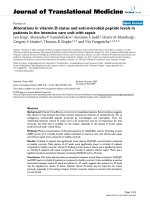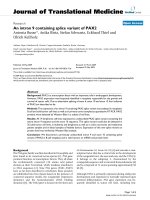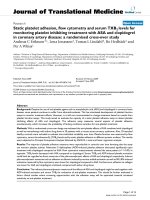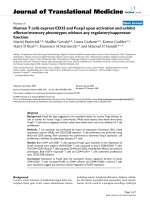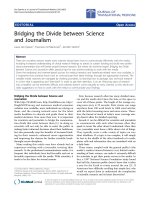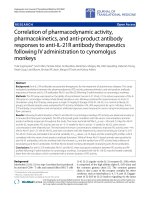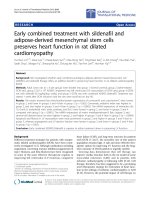Báo cáo hóa học: " Nanoscale potassium niobate crystal structure and phase transition" ppt
Bạn đang xem bản rút gọn của tài liệu. Xem và tải ngay bản đầy đủ của tài liệu tại đây (5.69 MB, 6 trang )
NANO EXPRESS Open Access
Nanoscale potassium niobate crystal structure
and phase transition
Haiyan Chen
1*
, Yixuan Zhang
2
and Yanling Lu
3
Abstract
Nanoscale potassium niobate (KNbO
3
) powders of orthorhombic structure were synthesized using the sol-gel
method. The heat-treatment tempe rature of the gels had a pronounced effect on KNbO
3
particle size and
morphology. Field emission scanning electron microscopy and transmission electron microscopy were used to
determine particle size and morphology. The average KNbO
3
grain size was estimated to be less than 100 nm, and
transmission electron microscopy images indicated that KNbO
3
particles had a brick-like morphology. Synchrotron
X-ray diffraction was used to identif y the room-temperature structures using Rietveld refinement. The ferroelectric
orthorhombic phase was retained even for particles smaller than 50 nm. The orthorhombic to tetragonal and
tetragonal to cubic phase transitions of nanocrystalline KNbO
3
were inve stigated using temperature-dependent
powder X-ray diffraction. Differential scanning calorimetry was used to examine the temperature dependence of
KNbO
3
phase transition. The Curie temperature and phase transition were independent of particle size, and
Rietveld analyses showed increasing distortions with decreasing particle size.
Keywords: potassium niobate, crystal structure, phase transition, nanoscale powder.
Background
Lead oxide-based perovskites are a commonly used
piezoelectric materi al and are now widely used in trans-
duc ers and other electromechanical devices [1-4]. How-
ever, the high toxicity and high processing vapor
pressure of lead oxide cause serious environmental pro-
blems. A promising way to address this issue is to
develop lead-free piezoelectric ceramics to minimize
lead pollution. Recently, as demand has increased, many
studies have focused on the development of high-quality
lead-free piezoelectric materials [5-7].
Potassium niobate (KNbO
3
) is a ferroelectric com-
pound with a perovskite-type structure and is a promis-
ing piezoelectric material owing to superior coupling in
its single crystal form [8,9] . KNbO
3
materials have
attr acted conside rable attention for applications in lead-
free piezoelectric materials. KNbO
3
has an orthorhom-
bic structure and is a well-known ferroelectric material
with extensive applications in electromechanical, non-
linear optical, and other technological fields [10-13].
KNbO
3
phase transition temperatures have already
been determined. KNbO
3
can exist in orthorhombic, tet-
ragonal, and cubic phases above room temperature, and
at ambient pressure, it exhibits two structural transitions
with decreasing temperature: cubic to tetragonal at 691
K and tetragonal to orthorhombic at 498 K [14]. The
cubic pha se is paraelectric while the remaining two are
ferroelectric; however, phase transitions of nanoscale
KNbO
3
have not yet been reported in detail.
The phase transition temperatures of ferroelectric
ceramics are size dependent, with the ferroele ctric phase
becoming unstable at room temperature when the parti-
cle diameter decreases below a critical size [15-17].
However, this critical size usually enc ompasse s a broad
size range. Experimental discrepancies may arise because
of intrinsic differences between ferroelectric samples,
and several theoretical models based on Landau theory
overestimate the critical sizes [18]. Therefore, the phase
structure of nanoscale KNbO
3
at room temperature
requires further investigations.
The current work is a systematic stud y of the crystal
structure and phase transitions of nanoscale KNbO
3
,
synthesized using the sol-gel method. The aim was to
investigate the size dependence of the ferroelectric
* Correspondence:
1
Institute of Marine Materials Science and Engineering, Shanghai Maritime
University, 1550 Harbor Avenue, Lingang New City, Shanghai 201306, China
Full list of author information is available at the end of the article
Chen et al. Nanoscale Research Letters 2011, 6:530
/>© 2011 Chen et al; licensee Springer. This is an Open Access ar ticle distributed under the terms of the Creative Commons Attribution
License ( which permits unrestricted use, distribution, a nd reproduction in any medium,
provided the original work is properly cited.
phase and the phase transition temperatures of na nos-
cale KNbO
3
powders.
Results and discussion
Typical field emission scanning electron microscopy
(FESEM) and transmission electron microscopy (TEM)
images of KNbO
3
powders obtained from heat-treating
gels at 600°C, 700°C, and 800°C are shown in Figure 1.
Particle sizes were found to be mu ch smaller than those
produced by conventional mixed-oxide processing. The
600°C sample in Figure 1a showed that most primary
particles were < 50 nm in size, but many of these had
Figure 1 FESEM images of nanoscale KNO
3
powders obtai ned by heat- treating gels.At(a)600°C,(b) 700°C, and (c) 800°C. (d, e, f) TEM
images of a nanocrystallite from (a), (b), and (c), respectively.
Chen et al. Nanoscale Research Letters 2011, 6:530
/>Page 2 of 6
clustered into agglomerates. Raising the temperature to
700°C resulted in particle sizes increasing to approxi-
mately 70 nm, as s hown in Figure 1b. Parti cles of up to
approximately 80 nm in size were present in the 800°C
sample shown in Figure 1c. Figure 1d, e, f shows TEM
images of nanoscale KNbO
3
particles in a brick-like
morphology. Increasing heat-treatment temperature led
to an increase in particle size, which was accompanied
by an incremental increase in the brick-like morphology.
The average grain size of aggregated KNbO
3
powders
was estimated to be < 100 nm. Table 1 shows average
particle sizes obtained at different temperatures esti-
mated from FESEM and TEM images, and the given
error was ± 1 standard deviation.
Rietveld refinement results of synchrotron X-ray dif-
fraction (XRD) data for KNO
3
powders obtained by
heat-treating gels at 600°C, 700°C, and 800°C are given
in Table 2, and the corresponding XRD patterns are
shown in Figure 2. Each powder crystallized in a perovs-
kite phase with an orthorhombic structure (space group
Amm2) at room temperature. Orthorhombic KNbO
3
is
thermodynamically stable at room temperature, and
orthorhombic KNbO
3
crystals have potential in applica-
tions as ferroelectric and nonlinear optical materials.
The ferroelectric orthorhombic phase was retained even
for particles smaller than 50 nm.
A cell volume p lot is shown in Figure 3, and cell
volume increased with decreasing particle size. A n
increase in unit cell volume has been reported for many
metal oxides and ferroelectric materials [19-22]. The
most co nsistent explanation for this in small oxide
particles is the effect of the truncated attractive Made-
lung potential that holds the oxide lattice together [23].
The Rietveld analysis showed in creasing distortions with
decreasing particle size.
Figure 4 shows temperature-dependent XRD patterns
of nanoscale KNO
3
powders obtained by heat-treating
gels at different temperatures. Three structural types
were distinguished by the diffraction at 44° to 46° 2 θ.
The clearly split peaks were indexed to the 022 and 200
planes for the orthorhombic phase. Broad diffractions of
reversed intensity to those of orthorhombic diffractions
Table 1 Particle size dependence on gel heat-treatment
temperature
Heat-treatment temperature (°C) 600 700 800
Particle size (nm) 40 ± 10 70 ± 15 80 ± 15
Table 2 Rietveld refinement results of synchrotron XRD
data collected at l = 1.2348 Å
Heat-treatment
temperature (°C)
600 700 800
Crystal structure Orthorhombic Orthorhombic Orthorhombic
Space group Amm2 Amm2 Amm2
Unit cell dimensions
a (Å) 4.004135 4.006313 4.007833
b (Å) 5.737700 5.726862 5.724034
c (Å) 5.742700 5.736795 5.734393
Atomic coordinates XYZ
O1(4d) 0 0.254 0.285
O2(2b) 0.500 0 0.021
K (2b) 0.500 0 0.517
Nb (2a) 0 0 0
R
wp
of all samples was < 10%.
Figure 2 Synchrotron XRD patterns of nanoscale KNO
3
powders obtained by heat-treating gels at the stated
temperature. l = 1.2348 Å.
Figure 3 Rietveld refinement of synchrotron data. For nanoscale
KNO
3
powders showing cell (a) parameters and (b) volume.
Chen et al. Nanoscale Research Letters 2011, 6:530
/>Page 3 of 6
Figure 4 XRD patterns showing phase transition of nanoscale KNO
3
powders. Obtained upon heat-treating gels at differe nt temperatures:
(a) orthorhombic to tetragonal (600°C), (b) tetragonal to cubic (600°C), (c) orthorhombic to tetragonal (700°C), (d) tetragonal to cubic (700°C), (e)
orthorhombic to tetragonal (800°C), and (f) tetragonal to cubic (800°C).
Chen et al. Nanoscale Research Letters 2011, 6:530
/>Page 4 of 6
were considered to correspond to 002 and 020 tetrago-
nal diffrac tions, since a reversed intensity was observed
for the corresponding peaks of the high-temperature tet-
ragonal phase above approximately 220°C. The single
peak of the 200 plane was identified as that of the cubic
phase above approximately 430°C.
Figure 4 shows that there was no obvious difference in
transiti on temperature between the three samples. T em-
perature-dependent XRD showed that the actual transi-
tion temperature was nearly unchanged, and that the
Curie temperature (T
C
) and phase trans ition were inde-
pendent of particle size.
To further investigate the phase transition of nanos-
cale KNbO
3
, th e differential scanning calorimetry (DSC)
analyses were undertaken and the results are shown in
Figure 5. Table 3 shows transition temperatures
observed from DSC, for the three nanoscale KNbO
3
samples of different particle sizes. The lower
temperature corresponded to the phase change from
orthorhombic to tetragonal, and the higher temperature
was th at from tetragonal to cubic. DSC results show ed
that phase transition was independent of particle size.
Conclusions
Nanoscale KNbO
3
powders were synthesized using the
sol-gel method. The average KNbO
3
grain size was esti-
mated to be within 100 nm from FESEM and TEM
images, and TEM images showed that nanoscale KNbO
3
particles had a brick-like morphology.
Synchrotron XRD and Rietveld refinement showed
that the ferroelectric orthorhombic phase was retained
at room temperature, even for particles smaller than 50
nm. Temperature-dependent XRD confirmed that the
actual transition temperature was nearly unchanged and
that the T
C
and phase transit ion were independent of
particl e size. Rietveld analysis showed increasing distor-
tions with decreasing particle size.
Methods
Precursor solutions were prepared using the sol-gel
method reported in the literature [24]. K-ethoxide, Nb-
pentaethoxide, 2-methoxyethanol, K-ethoxide, and Nb-
pentaethoxide were dissolved in 2-methoxyethanol and
refluxed at 120°C for 90 min in dry N
2
. The concentra-
tions of all precursor solutions were 0.32 mol/L.
Weighed gel samples in Pt cells were calcined at 600°C
to 800°C for 3 min in air to obtain crystalline powders,
with a heating rate of 10°C/min.
Powder sizes and morphologies were examined using
FESEM (JEOL JSM-7500F; JEOL Ltd., Tokyo, Japan) and
TEM (JEOL JEM-2010; JEOL Ltd.). Crystal structures
were determined using high-resolution synchrotron
radiation diffractometry at the BL14B1 beam line of
Shanghai Synchrotron Radiation Facility, using 1.2398 Å
X-rays with a Huber 5021 6-axes diffractometer (energy
= 3.5 GeV). Structural refinements were performed
using the Rietveld analysis program X’ Pert Highscore
Plus (PANalytical X-ray Company, Almelo, The Nether-
lands). Phase transitions were investigated using non-
ambient XRD (PAN alytical X’pert Pro, Cu Ka,40kV,
40 mA) with a Pt strip stage from ambient temperature
to 600°C. The differential scanning calorimetry
(NETZSCH STA 449F3, Selb, Germany) was used to fol-
low the phase transitions. Nitrogen was used in the DSC
measurement at a flow rate of 50 ml/min with a heating
rate of 5°C/min. The measurement was carried out in
the temperature range of 50°C to 500°C.
Figure 5 DSC plots of nanoscale KNO
3
powders obtained by
heat-treating gels.At(a) 600°C, (b) 700°C, and (c) 800°C.
Table 3 Transition temperature observed from DSC
Heat-treatment temperature (°C) 600 700 800
Transition temperature (°C) 213.2, 414.5 215.5, 415.7 211.2, 412.5
Chen et al. Nanoscale Research Letters 2011, 6:530
/>Page 5 of 6
Abbreviations
DSC: differential scanning calorimetry; FESEM: field emission scanning
electron microscopy; KNbO
3
: potassium niobate; TEM: transmission electron
microscopy; XRD: X-ray diffraction.
Acknowledgements
This work was supported by the Innovation Program of the Shanghai
Municipal Education Commission in China (grant no. 11YZ128).
Author details
1
Institute of Marine Materials Science and Engineering, Shanghai Maritime
University, 1550 Harbor Avenue, Lingang New City, Shanghai 201306, China
2
State Key Laboratory of Metal Matrix Composites, Shanghai Jiaotong
University, 800 Dongchuan Road, Shanghai 200240, China
3
Shanghai
Institute of Applied Physics, Chinese Academy of Sciences, 239 Zhangheng
Road, Shanghai 201204, China
Authors’ contributions
HC performed the sample preparation, analyzed the materials, and
interpreted the results. YZ participated in the XRD, FESEM, TEM, and DSC
measurements. YL participated in the synchrotron XRD measurements. All
authors read and approved the final manuscript.
Competing interests
The authors declare that they have no competing interests.
Received: 1 June 2011 Accepted: 23 September 2011
Published: 23 September 2011
References
1. Jaffe B, Cook WR, Jaffe H: Piezoelectric Ceramics New York: Academic Press;
1971.
2. Uchino K: Piezoelectric actuators 2008: Key factors for commercialization.
Adv Mater Res 2008, 55-57:1-9.
3. Lee JH, Hwang KS, Kim TS: The microscopic origin of residual stress for
flat self-actuating piezoelectric cantilevers. Nanoscale Res Lett 2011,
6:55-60.
4. Desfeux R, Ferri A, Legrand C, Maës L, Da Costa A, Poullain G, Bouregba R,
Soyer C, Rèmiens D: Nanoscale investigations of switching properties and
piezoelectric activity in ferroelectric thin films using piezoresponse force
microscopy. Int J Nanotechnol 2008, 5:827-837.
5. Saito Y, Takao H, Tani T, Nonoyama T, Takatori K, Homma T, Nagaya T,
Nakamura M: Lead-free piezoceramics. Nature 2004, 432:84-86.
6. Deng Z, Dai Y, Chen W, Pei XM, Liao JH: Synthesis and Characterization of
Bowl-Like Single-Crystalline BaTiO
3
Nanoparticles. Nanoscale Res Lett
2010, 5:1217-1221.
7. Harnagea C, Cojocaru CV, Nechache R, Gautreau O, Rosei F, Pignolet A:
Towards ferroelectric and multiferroic nanostructures and their
characterisation. Int J Nanotechnol 2008, 5:930-962.
8. Wada S, Seike A, Tsurumi T: Poling treatment and piezoelectric properties
of potassium niobate ferroelectric single crystals. Jpn J Appl Phys 2001,
40:5690-5697.
9. Nakamura K, Tokiwa T, Kawamura Y: Domain structures in KNbO
3
crystals
and their piezoelectric properties. J Appl Phys 2002, 91:9272-9276.
10. Reeves RJ, Jani MG, Jassemnejad B, Powell RC, Mizell GJ, Fay W:
Photorefractive properties of KNbO
3
. Phys Rev B 1991, 43:71-82.
11. Zgonik M, Schlesser R, Biaggio I, Voit E, Tscherry J, Günter P: Materials
constants of KNbO
3
relevant for electrooptics and acoustooptics. J Appl
Phys 1993, 74:1287-1297.
12. Baumert JC, Walther C, Buchmann P, Kaufmann H, Melchior H, Gunter P:
KNbO
3
electro-optic induced optical wave-guide cutoffs modulator. Appl
Phys Lett 1985, 46:1018-1020.
13. Shoji I, Kondo T, Kitamoto A, Shirane M, Ito R: Absolute scale of second-
order nonlinear-optical coefficients. J Opt Soc Am Opt Phys 1997,
14B:2268-2294.
14. Shirane G, Danner H, Pavlovic A, Pepinsky R: Phase Transitions in
Ferroelectric KNbO
3
. Phys Rev 1954, 93:672-673.
15. Akdogan EK, Safari A: Thermodynamic theory of intrinsic finite size
effects in PbTiO
3
nanocrystals. II. Dielectric and piezoelectric properties.
J Appl Phys 2007, 101:064115.
16. Spanier JE, Kolpak AM, Urban JJ, Grinberg I, Ouyang L, Yun WS, Rappe AM,
Park H: Ferroelectric phase transition in individual single-crystalline
BaTiO
3
nanowire. Nano Lett 2006, 6:735-739.
17. Fong DD, Stephenson GB, Streiffer SK, Eastman JA, Auciello O, Fuoss PH,
Thompson C: Ferroelectricity in ultrathin perovskite films. Science 2004,
304:1650-1653.
18. Wang CL, Smith SRP: Landau theory of asymmetric behaviour in
ferroelectric thin films. Solid State Commun 1996, 99:559-562.
19. Ayyub P, Palkar VR, Chattopadhyay S, Multani MS: Effect of crystal size
reduction on lattice symmetry and cooperative properties. Phys Rev B
1995, 51:6135-6138.
20. Thapa D, Palkar VR, Kurup MB, Malik SK: Properties of magnetite
nanoparticles synthesized through a novel chemical route. Mater Lett
2004, 58:2692-2694.
21. Li G, Boerio-Goates J, Woodfield BF, Li L: Evidence of linear lattice
expansion and covalency enhancement in rutile TiO
2
nanocrystals. Appl
Phys Lett 2004, 85:2059-2061.
22. Ishikawa K, Uemori T: Surface relaxation in ferroelectric perovskites. Phys
Rev B 1999, 60:11841-11845.
23. Smith MB, Page K, Siegrist T, Redmond PL, Walter EC, Seshadri R, Brus LE,
Steigerwald ML: Crystal structure and the paraelectric-to-ferroelectric
phase transition of nanoscale BaTiO
3
. J Am Chem Soc 2008,
130:6955-6963.
24. Tanaka K, Kakimoto KI, Ohsato H: Morphology and crystallinity of KNbO
3
-
based nano powder fabricated by sol-gel process. J Eur Ceram Soc 2007,
27:3591-3595.
doi:10.1186/1556-276X-6-530
Cite this article as: Chen et al.: Nanoscale potassium niobate crystal
structure and phase transition. Nanoscale Research Letters 2011 6:530.
Submit your manuscript to a
journal and benefi t from:
7 Convenient online submission
7 Rigorous peer review
7 Immediate publication on acceptance
7 Open access: articles freely available online
7 High visibility within the fi eld
7 Retaining the copyright to your article
Submit your next manuscript at 7 springeropen.com
Chen et al. Nanoscale Research Letters 2011, 6:530
/>Page 6 of 6

